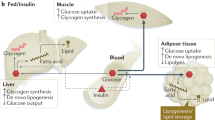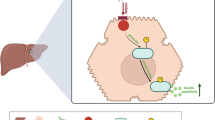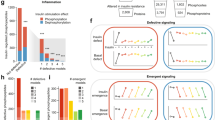Abstract
INTEGRATION of information between tyrosine kinase1 and G-protein-mediated pathways2 is necessary, but remains poorly understood. Here we use cells from transgenic mice harbouring inducible expression of RNA antisense to the gene encoding Giα2 (refs 3, 4) to show that Giα2 is critical for insulin action. Giα2 deficiency in adipose tissue and liver produces hyperinsulin-aemia, impaired glucose tolerance and resistance to insulin in vivo. Insulin resistance affects glucose-transporter activity and recruitment, counterregulation of lipolysis, and activation of glycogen synthase, all of which are cardinal responses to insulin5. Giα2 deficiency increases protein-tyrosine phosphatase activity and attenuates insulin-stimulated tyrosine phosphorylation of IRS (insulin-receptor substrate 1) in vivo. Giα2 deficiency creates a model for the insulin resistance characteristic of non-insulin-dependent diabetes mellitus (NIDDM)6, implicating Giα2 as a positive regulator of insulin action.
This is a preview of subscription content, access via your institution
Access options
Subscribe to this journal
Receive 51 print issues and online access
$199.00 per year
only $3.90 per issue
Buy this article
- Purchase on SpringerLink
- Instant access to full article PDF
Prices may be subject to local taxes which are calculated during checkout
Similar content being viewed by others
References
Ullrich, A. & Schlessinger, J. Cell 61, 203–212 (1990).
Gilman, A. G. A. Rev. Biochem. 56, 615–647 (1987).
Moxham, C. M., Hod, Y. & Malbon, C. C. Science 260, 991–995 (1993).
Moxham, C. M., Hod, Y. & Malbon, C. C. Devl Gen. 14, 266–273 (1993).
White, M. F. & Kahn, C. R. J. biol. Chem. 269, 1–4 (1994).
Reaven, G. M. Physiol. Rev. 75, 473–486 (1995).
Cohen, P., Parker, P. J. & Woodgett, J. R. in Molecular Basis of Insulin Action (ed. Czech, M. P.) 213–233 (Plenum, New York, 1985).
Lavan, B. E. & Lienhard, G. E. Biochem. Soc. Trans. 22, 676–680 (1994).
Cushman, S. W. & Wardzala, L. J. J. biol. Chem. 255, 4758–4762 (1980).
Milarski, K. L. & Saltiel, A. R. J. biol. Chem. 269, 21239–21243 (1994).
Noguchi, T. et al. Molec. cell. Biol. 14, 6674–6682 (1994).
Ahmad, F. & Goldstein, B. Am. J. Physiol.: Endocr. Metab. 268, E932–940 (1995).
Boylan, J. M. et al. J. clin. Invest. 90, 174–179 (1992).
Begum, N., Sussman, K. E. & Draznin, B. Diabetes 40, 1620–1629 (1991).
Meyerovitch, J., Backer, J. M. & Kahn, C. R. J. clin. Invest. 84, 976–983 (1989).
McGuire, M. C. et al. Diabetes 40, 939–942 (1991).
Mauro, L. J. et al. Adv. Prot. Phosphatases 7, 393–411 (1993).
Frangioni, J. V. et al. EMBO J. 12, 4843–4856 (1993).
Ezumi, Y., Takayama, H. & Okuma, M. J. biol. Chem. 270, 11927–11934 (1995).
Tamemoto, H. et al. Nature 372, 182–186 (1994).
Araki, E. et al. Nature 372, 186–190 (1994).
Bushfiled, M. et al. Biochem. J. 271, 365–372 (1990).
Gawler, D., Milligan, G., Spiegel, A. M., Unson, C. G. & Houslay, M. D. Nature 327, 224–232 (1987).
Wieland, O. Methods of Enzymatic Analysis (ed. O. Bergmeyer) Vol. 3, 1404–1414 (Academic, New York, 1974).
Guinovart, J. J. et al. FEBS Lett. 106, 284–288 (1979).
Lowry, O. H., Rosebrough, N. J., Farr, A. L. & Randall, R. J. J. biol. Chem. 193, 265–269 (1951).
Karnielli, E. et al. J. biol. Chem. 256, 4772–4777 (1981).
Foley, J. E., Cushman, S. W. & Salans, L. B. Am. J. Phys. 234, E112–119 (1978).
Meyers, M. G. et al. Molec. cell. Biol. 14, 3577–3587 (1994).
King, M. J. & Sale, G. J. Biochem. J. 256, 893–902 (1988).
Author information
Authors and Affiliations
Rights and permissions
About this article
Cite this article
Moxham, C., Malbon, C. Insulin action impaired by deficiency of the G-protein subunit Giα2. Nature 379, 840–844 (1996). https://doi.org/10.1038/379840a0
Received:
Accepted:
Issue date:
DOI: https://doi.org/10.1038/379840a0
This article is cited by
-
S-nitrosylation-mediated coupling of G-protein alpha-2 with CXCR5 induces Hippo/YAP-dependent diabetes-accelerated atherosclerosis
Nature Communications (2021)
-
G-Protein β3-Subunit Gene C825T Polymorphism and Cardiovascular Risk: An Updated Review
High Blood Pressure & Cardiovascular Prevention (2015)
-
Inhibitory G proteins and their receptors: emerging therapeutic targets for obesity and diabetes
Experimental & Molecular Medicine (2014)
-
Mitochondrial H2O2 as an enable signal for triggering autophosphorylation of insulin receptor in neurons
Journal of Molecular Signaling (2013)
-
Intracerebroventricular antisense knockdown of Gαi2 results in ciliary stasis and ventricular dilatation in the rat
BMC Neuroscience (2007)



